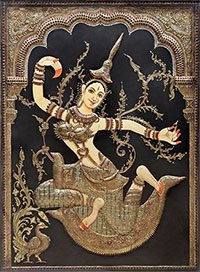Atavika, Āṭavīka, Aṭavika, Āṭavika: 17 definitions
Introduction:
Atavika means something in Hinduism, Sanskrit, the history of ancient India. If you want to know the exact meaning, history, etymology or English translation of this term then check out the descriptions on this page. Add your comment or reference to a book if you want to contribute to this summary article.
In Hinduism
Jyotisha (astronomy and astrology)
Source: Wisdom Library: Brihat Samhita by VarahamihiraĀṭavīka (आटवीक) refers to “forest men” (working for the king), according to the Bṛhatsaṃhitā (chapter 2), an encyclopedic Sanskrit work written by Varāhamihira mainly focusing on the science of ancient Indian astronomy astronomy (Jyotiṣa).—Accordingly, “We shall now proceed to give a brief description of (the qualifications of) a jyotiṣaka. [...] He must be able to interpret the language and gestures of fighting men and the like; he must be learned in the Ṣaḍguṇa and Upāya policies; he must be able to predict the success or failure of an undertaking; he must be able to interpret omens; he must have a knowledge of favourable halting places for the king’s army; he must be able to interpret the colour of ceremonial fires; he must know when to employ the ministers, spies, messengers and forest men [i.e., āṭavīka]; he must be able to give directions touching the captures of the enemy’s fortress”.

Jyotisha (ज्योतिष, jyotiṣa or jyotish) refers to ‘astronomy’ or “Vedic astrology” and represents the fifth of the six Vedangas (additional sciences to be studied along with the Vedas). Jyotisha concerns itself with the study and prediction of the movements of celestial bodies, in order to calculate the auspicious time for rituals and ceremonies.
Shaktism (Shakta philosophy)
Source: Google Books: ManthanabhairavatantramAṭavika (अटविक) [=aṭavi?] refers to “forests”, according to the Manthānabhairavatantra, a vast sprawling work that belongs to a corpus of Tantric texts concerned with the worship of the goddess Kubjikā.—Accordingly, “[...] Prabhu, Yogin, Ānanda, Āvalī, Ātīta, Pāda, and the rest called Kulas (are) all (like) rivers that fall into the root transmission. They, the princes and the gods, bodies, forests (aṭavika), villages, houses and others that are born from the root (transmission) are like rivers (that flow) from the mountain of Kula”.

Shakta (शाक्त, śākta) or Shaktism (śāktism) represents a tradition of Hinduism where the Goddess (Devi) is revered and worshipped. Shakta literature includes a range of scriptures, including various Agamas and Tantras, although its roots may be traced back to the Vedas.
Sports, Arts and Entertainment (wordly enjoyments)
Source: archive.org: Syainika Sastra of Rudradeva with English Translation (art)Āṭavika (आटविक) refers to “forest tribes”, according to the Śyainika-śāstra: a Sanskrit treatise dealing with the divisions and benefits of Hunting and Hawking, written by Rājā Rudradeva (or Candradeva) in possibly the 13th century.—Accordingly, “Hunting on horseback (āśvina) represents one of the eight subdivisions of Hunting (mṛgayā). [...] It leads to the acquisition of religious merit, by killing ferocious animals such as wolves and tigers, by the protection of standing crop, by the slaughter of stags and other animals, by an inspection of the forest, which serves so many useful purposes, by frightening the thieves, and by conciliating forest tribes (āṭavika-rañjana). [...]”.

This section covers the skills and profiencies of the Kalas (“performing arts”) and Shastras (“sciences”) involving ancient Indian traditions of sports, games, arts, entertainment, love-making and other means of wordly enjoyments. Traditionally these topics were dealt with in Sanskrit treatises explaing the philosophy and the justification of enjoying the pleasures of the senses.
India history and geography
Source: archive.org: Personal and geographical names in the Gupta inscriptionsĀṭavīka (आटवीक) is the name of a tribe mentioned in the Gupta inscriptions. The Gupta empire (r. 3rd-century CE), founded by Śrī Gupta, covered much of ancient India and embraced the Dharmic religions such as Hinduism, Buddhism and Jainism. These tribes (e.g., the Āṭavīkas, latin: Atavikas) migrated to places other than their original settlemenets and gave their names to the janapadas they settled. They replaced the old Vedic tribes in Punjab and Rajasthan though some of them are deemed as offshoots of the main tribe..
Source: Cologne Digital Sanskrit Dictionaries: Indian Epigraphical GlossaryĀṭavika.—(Ep. Ind., Vol. XIV, p. 303, text line 50), a kind of grains. (EI 20; HD), an officer in charge of forest tracts. See Arthaśāstra, I 12 (mentioned among the 18 tīrthas). Note: āṭavika is defined in the “Indian epigraphical glossary” as it can be found on ancient inscriptions commonly written in Sanskrit, Prakrit or Dravidian languages.

The history of India traces the identification of countries, villages, towns and other regions of India, as well as mythology, zoology, royal dynasties, rulers, tribes, local festivities and traditions and regional languages. Ancient India enjoyed religious freedom and encourages the path of Dharma, a concept common to Buddhism, Hinduism, and Jainism.
Languages of India and abroad
Sanskrit dictionary
Source: DDSA: The practical Sanskrit-English dictionaryAṭavika (अटविक).—A forester = आटविकः (āṭavikaḥ) q. v.
Derivable forms: aṭavikaḥ (अटविकः).
--- OR ---
Āṭavika (आटविक).—[aṭavyāṃ carati bhavo vā ṭhak]
1) A forester, a woodman, inhabitant of a forest; Mahābhārata (Bombay) 12.59.48; Manusmṛti 9.257.
2) A pioneer.
3) One of the six kinds of armies.
4) A chief of wild-tribes; Kau. A.1.1.
Derivable forms: āṭavikaḥ (आटविकः).
Source: Cologne Digital Sanskrit Dictionaries: Edgerton Buddhist Hybrid Sanskrit DictionaryĀṭavikā (आटविका).—(= Pali Āḷavī, compare Agrāṭavika), name of a city in Magadha, and of a river near it: Mūla-Sarvāstivāda-Vinaya ii.51.8, 9.
Source: Cologne Digital Sanskrit Dictionaries: Shabda-Sagara Sanskrit-English DictionaryAṭavika (अटविक).—m.
(-kaḥ) A wood-man, a forester. E. aṭavi a wood, vaka aff.
--- OR ---
Āṭavika (आटविक).—m.
(-kaḥ) A wood-man. E. aṭavī a wood, and ṭhañ aff.
Source: Cologne Digital Sanskrit Dictionaries: Benfey Sanskrit-English DictionaryĀṭavika (आटविक).—i. e. aṭavi + ika, m. 1. One who lives in forests, Mahābhārata 3, 15255. 2. A forest keeper.
Source: Cologne Digital Sanskrit Dictionaries: Cappeller Sanskrit-English DictionaryĀṭavika (आटविक).—[adjective] belonging to a wood; [neuter] woodman, forester.
Source: Cologne Digital Sanskrit Dictionaries: Monier-Williams Sanskrit-English Dictionary1) Aṭavika (अटविक):—[from aṭ] better See āṭavika
2) Āṭavika (आटविक):—[from aṭ] a m. a woodman, forester.
3) b m. ([from] aṭavī), the inhabitant of a forest, [Manu-smṛti ix, 257; Mahābhārata] etc.
4) a forester, [Sāhitya-darpaṇa]
5) mfn. consisting of inhabitants of the forest (as an army), [Kāmandakīya-nītisāra]
Source: Cologne Digital Sanskrit Dictionaries: Goldstücker Sanskrit-English DictionaryAṭavika (अटविक):—m.
(-kaḥ) A wood-man, a forester. E. aṭavi, taddh. aff. ṭhak. See āṭavika, which appears to be the more correct form of this word.
Source: Cologne Digital Sanskrit Dictionaries: Yates Sanskrit-English Dictionary1) Aṭavika (अटविक):—(kaḥ) 1. A woodman.
2) Āṭavika (आटविक):—(kaḥ) 1. m. A woodman.
Source: DDSA: Paia-sadda-mahannavo; a comprehensive Prakrit Hindi dictionary (S)Āṭavika (आटविक) in the Sanskrit language is related to the Prakrit word: Āḍaviya.
[Sanskrit to German]
Sanskrit, also spelled संस्कृतम् (saṃskṛtam), is an ancient language of India commonly seen as the grandmother of the Indo-European language family (even English!). Closely allied with Prakrit and Pali, Sanskrit is more exhaustive in both grammar and terms and has the most extensive collection of literature in the world, greatly surpassing its sister-languages Greek and Latin.
Kannada-English dictionary
Source: Alar: Kannada-English corpusĀṭavika (ಆಟವಿಕ):—
1) [noun] (masc.) one who plays a game; a player.
2) [noun] (masc.) a stage performer.
--- OR ---
Āṭavika (ಆಟವಿಕ):—
1) [noun] (masc.) one who dwells in a forest.
2) [noun] a wicked or mischievous man.
Kannada is a Dravidian language (as opposed to the Indo-European language family) mainly spoken in the southwestern region of India.
See also (Relevant definitions)
Starts with: Atavikabala, Atavikabhupati, Atavikabuddhi, Atavikam, Atavikanam, Atavikatana.
Ends with: Agratavika, Gopatavika, Patavika, Vatavika.
Full-text: Atavya, Atavi, Ataviga, Atavikam, Atavin, Agratavika, Atavibala, Adaviya, Alavaka, Ataviya, Gopatavika, Atavaka, Hastaka, Ranjana, Gopa, Asara.
Relevant text
Search found 11 books and stories containing Atavika, Āṭavīka, Aṭavika, Āṭavika, Āṭavikā; (plurals include: Atavikas, Āṭavīkas, Aṭavikas, Āṭavikas, Āṭavikās). You can also click to the full overview containing English textual excerpts. Below are direct links for the most relevant articles:
Manusmriti with the Commentary of Medhatithi (by Ganganatha Jha)
Verse 7.184-185 < [Section XIII - War]
Mahabharata (English) (by Kisari Mohan Ganguli)
Section LVI < [Abhimanyu-badha Parva]
Maha Prajnaparamita Sastra (by Gelongma Karma Migme Chödrön)
Appendix 2 - Episode of Hastaka of Āḷavi < [Chapter XLII - The Great Loving-kindness and the Great Compassion of the Buddhas]
Appendix 4 - The story of Hastaka Āṭavika < [Chapter XV - The Arrival of the Bodhisattvas of the Ten Directions]
Appendix 2 - The story of Hastaka Śākyaputra < [Chapter LII - Elimination of the Triple Poison]
List of Mahabharata tribes (by Laxman Burdak)
Matangalila and Hastyayurveda (study) (by Chandrima Das)
Kautilya Arthashastra (by R. Shamasastry)
Chapter 10 - The Character of Ministers < [Book 1 - Concerning Discipline]
Chapter 16 - The Mission of Envoys < [Book 1 - Concerning Discipline]